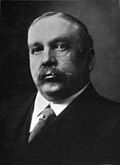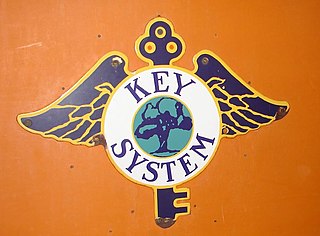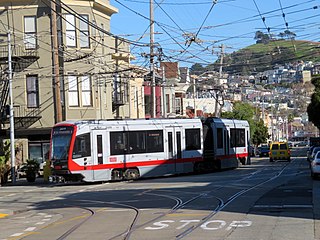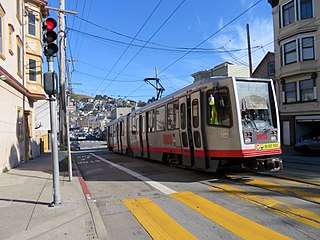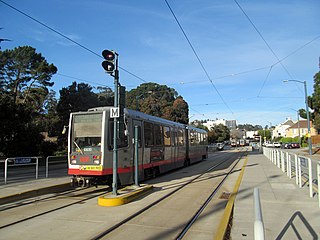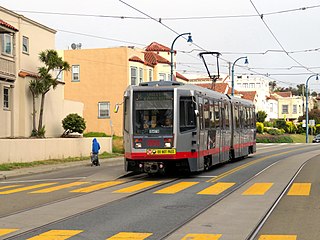Initial founding
Brothers Isaac (Behrend) and Fabian Joost were real-estate developers in the neighborhood of Sunnyside. They saw the success of Frank Julian Sprague's Richmond Union Passenger Railway in Richmond, Virginia, and determined that an electric streetcar system running through their then-isolated portion of the city would be a good way to boost property values. In 1890, the San Francisco & San Mateo Railway Co. was incorporated. [2] On July 29, 1891, the railroad held a silver spike ceremony at Ocean View at the border between the two counties; Behrend Joost, president of the railroad, physically drove the final spike symbolically joining the rail segments. At the time, poles for the overhead lines extended as far as Holy Cross Cemetery. [3] The railway opened for business on April 26, 1892. [4] [5] A double-track railway ran from the Ferry Building at the foot of Market Street, over Steuart Street, Harrison Street, Bryant Street, Fourteenth Street, and Guerrero Street, with single track extending down San Jose Avenue to the Baden area of South San Francisco, [6] with a transfer required at 30th Street and San Jose Avenue. The line did not actually extend to the city of San Mateo, which lies 13 miles (20.9 km) further to the south, although it did run through part of the County of San Mateo. [7]

A powerhouse and car barn were built on Sunnyside Avenue one block off San Jose Avenue. The streetcars were of the California car design, with an enclosed center section and open center bench seating at either end of the car, similar to the cable cars used on the California Street line. Single-truck (four wheel) cars 26 feet (7.9 m) long were used on the double track line, and 28-foot (8.5 m) two-truck cars were used on San Jose Avenue. [6]
The route chosen by the company was rather unfortunate. They were not able to traverse any of the major streets, as rival streetcar companies already had lines on them. Furthermore, beyond 30th Street, the area of the city was not yet fully settled. With an unpopular route that led to sparsely populated neighborhoods, the company could not generate much revenue despite having nearly 4,200,000 riders annually. [7] This trend continued after the merger into URR well into the 1920s, when electric streetcars were at their most profitable. [1]
The line also gained a reputation for being dangerous. Although the company had built a counterweight system to slow cars on a Harrison Street hill between 2nd and 3rd, no such system was added to another hill on Chenery Street, which became the site of a number of runaway cars. Even an injury to a boy there on opening day did not spur the company to action. After a few such accidents, the company finally relaid the track and purchased cars with better brakes. [1] The counterweight was removed in 1893. [8]
By late 1892, the company opened a second line from the Mission District to Douglass Street via 18th Street, hoping to cash in on the Golden Gate Park traffic (the intersection of Douglass and 18th, however, is about 0.8 miles (1.3 km) southeast of the park). They were able to extend this to within five city blocks of the park, but could go no further because the Market Street Railway Company had their line on Frederick Street, which denied the SF&SM any further access. [1]
The company did find one new source of revenue, however. The SF&SM served Holy Cross, Lawn, Mt. Olivet, Cypress, and Woodlawn cemeteries, all in Colma (via the cemeteries' own tracks). As a result, funeral traffic became a consistent source of income. Special funeral trains were run consisting of a short mail, express, and funeral car carrying the casket, followed by one or more conventional passenger cars carrying mourners. A September 18, 1893 newspaper article describing the first use of the car notes a charge of $10 to carry the casket, with the regular fare of 10 cents for each mourner. [6]
Unfortunately, this was not enough to cover the debt incurred from the line's initial construction as well as subsequent interest payments, forcing the company into receivership. The receiver subsequently was granted permission by the Market Street Railway to use a portion of their line and the SF&SM 18th & Park line finally opened in November 1894 (this eventually was converted to San Francisco's first trolleybus service in 1935). New cars, the first in the city to have front windows, [1] also arrived in summer of 1894, making it finally possible to go from the Ferry Building to Baden without a transfer.
